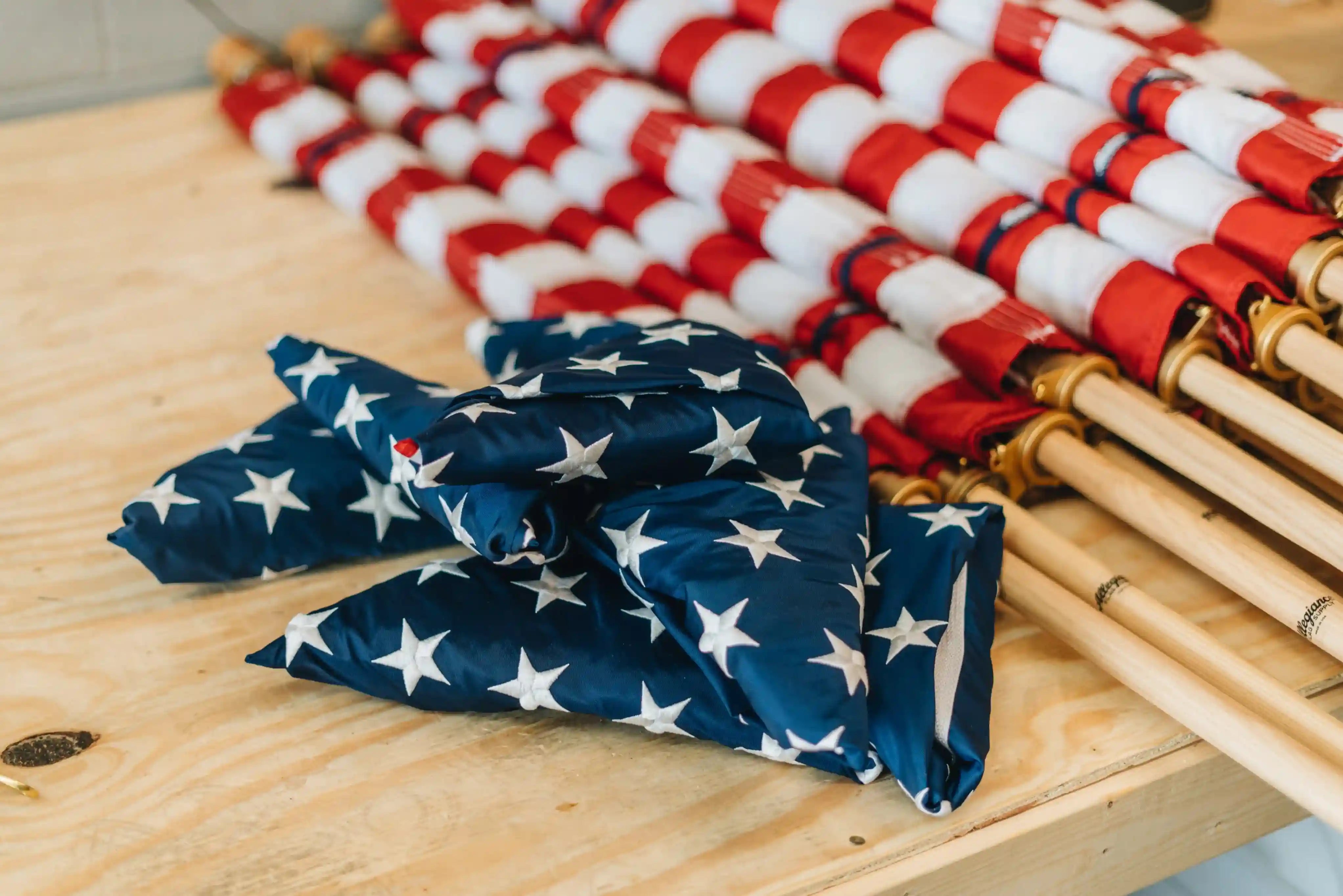The United States Flag has fifty, five-pointed, silver stars on the canton of the flag. Each star symbolizes a state. However, America originally started with thirteen stars representing the original thirteen colonies. The road to fifty is paved with iconic battles like the Alamo and Lexington. There were also many real estate transactions that changed not just America but the world.

Star Design Origins
The number of stars on the flag has hidden depths of meaning behind them that go beyond just representing our country today. The design of stars goes back thousands of years, and the fifty that the Union has garnered has a more complicated story than some lead on to be.
Historical Stars
One of the earliest renditions of the flag of the United States to be commissioned, the Betsy Ross flag, was supposed to originally feature six-pointed stars. This star is commonly referred to as the Star of David and is a common symbol for Judaism.
This wasn't always the case for this star design, though. Going back thousands of years, the six-pointed star was a very common geometric shape in many cultures. Archeologists have found all kinds of architecture from the Common Era with six-pointed stars.
However, it’s agreed upon that these symbols were not related to Judaism but just simple decorative pieces. The Star of David is found throughout many Jewish texts (like in the Book of Boundary). However, it wasn’t considered an official symbol for the religion until the mid 14th century.
During the same time, Christianity was spreading at an explosive rate, and the Christian Cross could be found everywhere. Emperor Charles IV of the Holy Roman Empire allowed the Jewish people of Prague to adopt a flag with a symbol.
The Jewish people of Prague chose a red flag with a Star of David in the middle. The Star of David did not catch on as the most popular symbol for Jewish people until the 18th century. It was not until 1897 that the star became the international symbol at the first Zionist Congress in Switzerland. It persisted in Jewish culture and was put on the flag for Israel in 1948.
Nonetheless, it’s still a fascinating symbol rich with historical value and meaning. It’s only recently that it has been considered a religious symbol but has permeated cultures, art, and architecture throughout the centuries.
Betsy Ross
Born and raised in Pittsburgh, Pennsylvania, Betsy Ross was an upholsterer and designer. She reportedly made beds and other items for George Washington. She even made musket cartridges for the Revolutionary War effort.
In 1776, George Washington, Robert Morris, and George Ross formed a secret committee for the Continental Congress and approached Ross for a new flag to represent America. At first, the committee requested a flag with thirteen stars with six points each.
Ross suggested that the stars should have five points. The committee argued that the six-pointed stars would be easier to make, but Ross demonstrated on paper and with some scissors that 5-pointed stars were actually easier to sew.
Upon seeing the demonstration, George Washington and the others agreed on the five-pointed stars. A seemingly unremarkable reason as to why our stars are the shape that they are.
Although the first “stars and stripes” is affectionately referred to as the Betsy Ross flag, it’s a common misconception to refer to it as the first American flag. The Grand Union flag is largely considered to be the first flag to represent the US.

The Union flag has thirteen alternating red and white stripes and has a British Union Jack in the canton. This design was, essentially, a copy of the British East India Company flag. This trading company was founded in 1600 by the British government.
The trading company developed into one of the most powerful corporations in the history of the world. They even had their own private military force. There were a couple of reasons why the Continental Congress chose this design to represent the United States of America.
One of them was that it would strengthen the alliance between the colonies and the East India Company. They were seen as a powerful ally and were vital to the supply chains. The other reason was to show fealty to the British Empire.
The colonies wanted a diplomatic way of showing that they wanted to remain allies with Britain but also signify their independence as a sovereign nation at the same time. This obviously did not work.
The aggression and conflict lead to the commissioning of a new flag without the British Union Jack. The original colonies made a statement when putting the thirteen stars in the blue field of the canton. These newly declared states were independent.
These original states were: New Hampshire, Massachusetts, Rhode Island, New York, New Jersey, Pennsylvania, Delaware, Maryland, Virginia, North Carolina, South Carolina, and Georgia.
How We Got To 50
The story of the American flag is one of trials and tribulations. Land was fought for, bought, and politically acquired. The original thirteen colonies were just the beginning of the movement Westward.
First States
The first thirteen colonies wanted freedom and fought a seven-year war for it. In 1803, America made history with one of the largest international real estate transactions: The Louisiana Purchase.
With one set of votes and a flick of a pen, the United States essentially doubled in size. In one year, middle America was born, and there are now fifteen States occupying the region. The French government knew it couldn’t hold onto that land with such a small occupation force.
France was also trying to finance a war against Great Britain and suffering from other financial problems. It only made sense for them to cut their losses and run. After all, why fight a potential war and lose the land anyways when you can get paid to leave?
This was a time in North America’s history of uncertainty. There were many countries that wanted a piece of this continent, like Spain, Britain, France, etc. There was only one problem: it was really far away from Europe, and there weren’t enough people willing to occupy the region.
Americans had a distinct advantage: They were already established on the continent and had the ability to expand. The reasons we bought the territory were pretty important. The Mississippi River and the Port of New Orleans were extremely advantageous.
These two aspects of the deal were crucial to American expansion. The Port of New Orleans was tactically advantageous to our military, and the Mississippi River provided water and transportation.
The region that was bought for $15 Million paved the way for American expansion into the West. Florida was a curious case in the creation of the modern East Coast. It was occupied and claimed by Spain from the late 1500s to the mid-1800s.

In the early 1800s, Florida was seen as a potential weak point in national security. It was a great spot for potential European invaders to make landfall and set up a base for an attack. The Southern States were also having trouble with Indigenous People coming over the border and attacking.
In 1818, President Monroe sent future President Andrew Jackson to the border to defend the Southern States from attack. Jackson proceeded to ignore the part where he was only supposed to defend the border and not actually enter Florida.
Jackson raided native tribes and even replaced a Spanish mayor with an American one. This obviously made the Spanish very angry, but instead of the American government apologizing, they doubled down.
The Americans intimidated Spain into just giving up the land because it would be too costly and difficult of a fight, especially as Spain was still recovering from a war with Napoleon.
Last States
Texas was originally owned by Mexico, and the Mexican government leased a bunch of that land to American immigrants. These Americans brought a very independent mindset to these lots and began ignoring all of the Mexican laws and rules.
Mexico sent troops to quell the rowdiness, but this resulted in a violent conflict. Eventually, Texas won and declared themselves a sovereign nation but soon joined the Union and became a new state in December of 1845.
After the Mexican American War, Mexico gave up the entire Southwest, including California. States in the Northwest, like Oregon and Washington, were originally occupied by the British became states in the mid to late 1800s.
Hawaii and Alaska were the last two states to enter the Union. Alaska was bought from the Russians at a shockingly low price because it was too costly and difficult for them to hold. Hawaii was acquired for its natural resources and strategically advantageous location for military forts and trading routes.
The admission of these two states led to the 50-star flag we know today.
Hidden Depths
The stars on our flag are more than just a representation of the number of states in the Union. They represent America’s willingness to be independent and free from foreign influence. The path the United States took was a complicated and innovative venture in expansion.
Not only does our flag inspire us today, but Francis Scott Key, a prisoner aboard a British ship, reportedly saw "Old Glory" (the US flag) standing during an attack on Fort McHenry during the War of 1812. He penned "The Star-Spangled Banner" based on US valor, vigilance, hardiness, and perseverance. This song would later become our national anthem.
Like Francis Scott Key, at Allegiance Flag Supply, we understand that the American flag is a sight to behold. That’s why we had to create an American-made flag that brings pride to wherever you fly it, just like our Founding Fathers.
Sources:
Betsy Ross | U.S. Department of the Interior
Becoming Part of the United States | Classroom Materials at the Library of Congress





